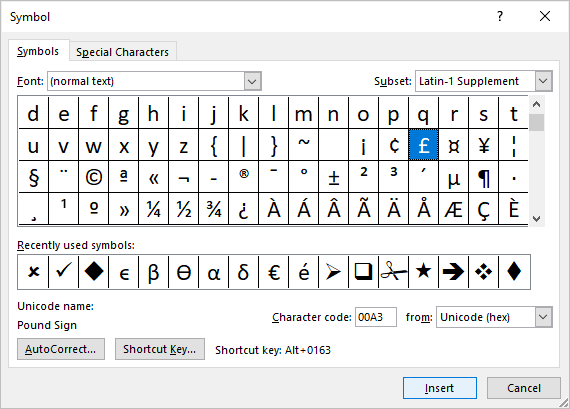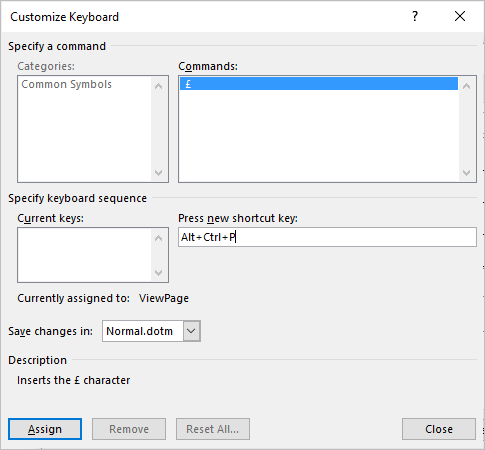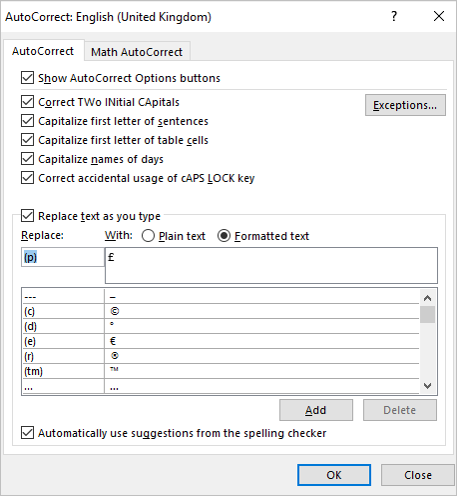Insert the British Pound Sign or Symbol in Microsoft Word Documents (with Shortcuts)
by Avantix Learning Team | Updated February 11, 2022
Applies to: Microsoft® Word® 2013, 2016, 2019 or 365 (Windows)
You can insert the Pound sign or symbol (£) in a Word document using built-in Word commands or keyboard shortcuts (including Alt code, AutoCorrect or built-in shortcuts). This article applies to the British currency symbol, not the pound sign (#) or hash tag.
Recommended article: How to Check Word Count in Microsoft Word (4 Ways)
In this article, we'll look at 4 ways to insert or type the Pound symbol in a Word document:
- Use the Insert Symbol command
- Press Alt and then enter a number sequence
- Create and use a Word shortcut
- Create and use an AutoCorrect entry
Do you want to learn more about Microsoft Word? Check out our virtual classroom or in-person Word courses >
1. Insert the Pound symbol using Insert Symbol
To insert the Pound sign or symbol using Insert Symbol in the Ribbon in Word:
- Position the cursor in the Word document where you want to insert the Pound symbol.
- Click the Insert tab in the Ribbon.
- In the Symbols group, click Symbol. A drop-down menu appears.
- Click More Symbols. A dialog box appears.
- If necessary, click the Symbols tab.
- Select (normal text) from the Font drop-down menu.
- Select Latin-1 Supplement from the Subset drop-down menu.
- Click the pound symbol (£).
- Click Insert.
- Click Close.
The Insert Symbol dialog box appears as follows (with £ selected):
2. Insert the Pound symbol using an Alt code keyboard shortcut
To insert the Pound sign or symbol in a Word document using an Alt code keyboard shortcut:
- Position the cursor where you want to insert the Pound symbol.
- Press and hold Alt + 0163 or Alt + 156 on the numeric keypad.
If the sequence doesn't work, press NumLock on the numeric keypad. If you don't have a numeric keypad on your laptop, you may be able to access number keys at the top of your keyboard in combination with another key (like Fn).
3. Create your own custom keyboard shortcut
If you insert the Pound symbol frequently, you can create your own keyboard shortcut as well.
To create a custom Word keyboard shortcut for the Pound symbol:
- Position the cursor in a Word document.
- Click the Insert tab in the Ribbon.
- In the Symbols group, click Symbol. A drop-down menu appears.
- Click More Symbols. A dialog box appears.
- If necessary, click the Symbols tab.
- Select (normal text) from the Font drop-down menu.
- Select Latin-1 Supplement from the Subset drop-down menu.
- Click the Pound symbol (£).
- Click Shortcut. A dialog box appears.
- Click in the box below Assign New Shortcut key.
- Press the keys you want to assign (such as Ctrl + Alt + P). Don't type any text, just press the keys. Be careful not to override a useful built-in shortcut such as Ctrl + P.
- Click Assign. Typically the location for these shortcuts is the Normal (or default) template.
- Click Close twice.
Test the shortcut in your document by pressing the assigned keys.
Below is the Customize Keyboard dialog box in Word to create a shortcut for the pound symbol:
This shortcut is typically added to the Normal template so when you exit the program, Word may prompt you to save the Normal template. If your IT department has disabled modification of the Normal template, you won't be able to use this method.
4. Create your own AutoCorrect shortcut
You can also add and use an AutoCorrect shortcut.
To add your own AutoCorrect shortcut for the Pound symbol:
- Position the cursor in a Word document.
- Click the Insert tab in the Ribbon.
- In the Symbols group, click Symbol. A drop-down menu appears.
- Click More Symbols. A dialog box appears.
- If necessary, click the Symbols tab.
- Select (normal text) from the Font drop-down menu.
- Select Latin-1 Supplement from the Subset drop-down menu.
- Click the Pound symbol (£).
- Click AutoCorrect. A dialog box appears.
- Enter the characters you want to use in the Replace dialog box such as (p). The pound symbol should appear on the right.
- Click Add.
- Click OK.
- Click Close.
To use the AutoCorrect entry, type the characters you entered in Replace, such as (p), and then press the Spacebar.
The AutoCorrect dialog box appears as follows (to create a pound AutoCorrect entry):
The AutoCorrect shortcut is typically added to the Normal template so when you exit the program, Word may prompt you to save the Normal template. If your IT department has disabled modification of the Normal template, you won't be able to use this method.
Subscribe to get more articles like this one
Did you find this article helpful? If you would like to receive new articles, JOIN our email list.
More resources
How to Insert a Check Mark in Word (5 Ways)
14+ Shortcuts to Quickly Select Text in Microsoft Word
How to Show or Hide White Space in Word Documents
How to Insert or Type the Sigma Symbol in Word (Σ or σ)
How to Create a Table of Contents in Microsoft Word (Insert, Format and Update a TOC)
Related courses
Microsoft Word: Intermediate / Advanced
Microsoft Excel: Intermediate / Advanced
Microsoft PowerPoint: Intermediate / Advanced
Microsoft Word: Long Documents Master Class
Microsoft Word: Styles, Templates and Tables of Contents
Microsoft Word: Designing Dynamic Word Documents Using Fields
Our instructor-led courses are delivered in virtual classroom format or at our downtown Toronto location at 18 King Street East, Suite 1400, Toronto, Ontario, Canada (some in-person classroom courses may also be delivered at an alternate downtown Toronto location). Contact us at info@avantixlearning.ca if you'd like to arrange custom instructor-led virtual classroom or onsite training on a date that's convenient for you.
Copyright 2024 Avantix® Learning
You may also like
10 Word Shortcuts to Select Text Using a Keyboard
10 Timesaving Shortcuts to Select Text in Word Using Only a Keyboard by Avantix Learning Team | Updated March 21, 2024 Applies to: Microsoft® Word® 2013, 2016, 2019, 2021 or 365 (Windows) You can use several shortcuts in Word to select text in your documents using...
How to Generate Random Text in Word
Generate Random Text in Microsoft Word Documents (Like Lorem Ipsum or Latin Text) by Avantix Learning Team | Updated May 4, 2023 Applies to: Microsoft® Word® 2010, 2013, 2016, 2019, 2021 and 365 (Windows) If you are creating a Microsoft Word document, template or...
How to Center Text Vertically in a Word Table (and Fix Common Issues)
Center or Align Text Vertically in Word Table Cells by Avantix Learning Team | Updated June 15, 2023 Applies to: Microsoft® Word® 2016, 2019, 2021 and 365 (Windows) You can center or align text vertically in cells in a Word table using commands in the Table Design or...
Microsoft, the Microsoft logo, Microsoft Office and related Microsoft applications and logos are registered trademarks of Microsoft Corporation in Canada, US and other countries. All other trademarks are the property of the registered owners.
Avantix Learning |18 King Street East, Suite 1400, Toronto, Ontario, Canada M5C 1C4 | Contact us at info@avantixlearning.ca










